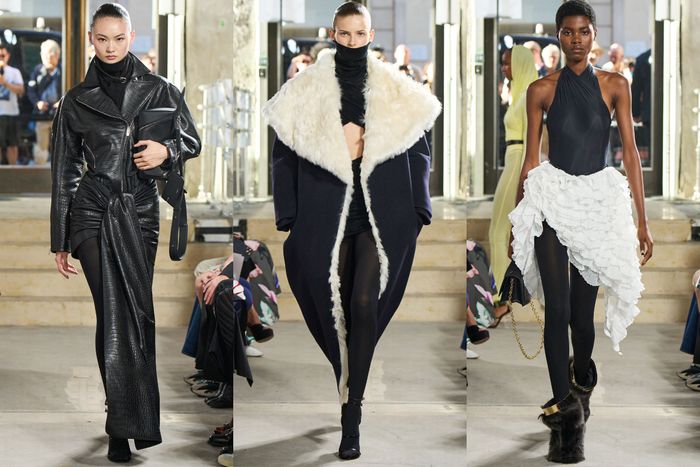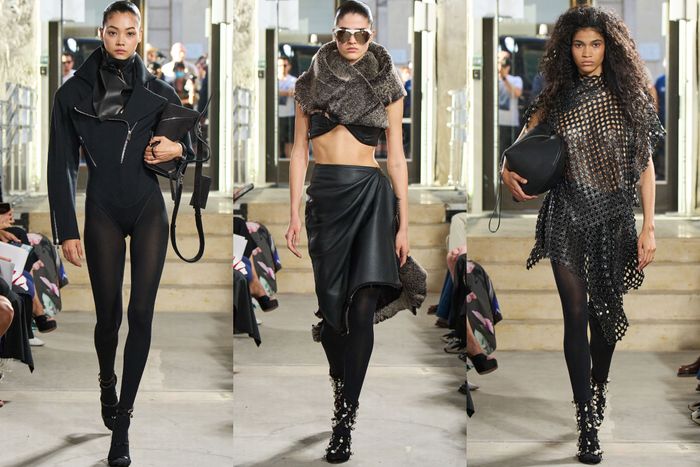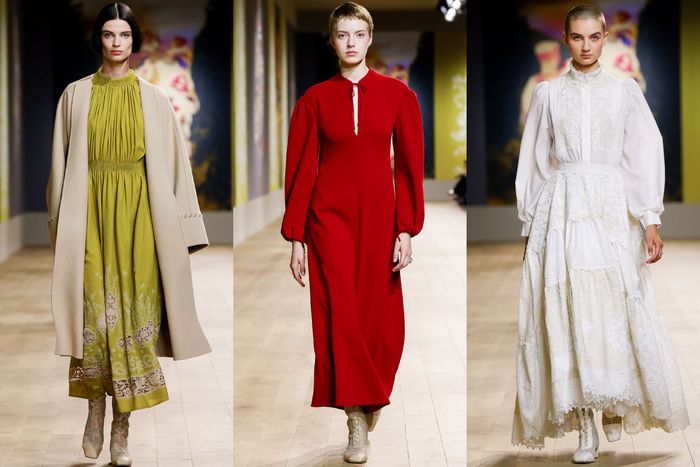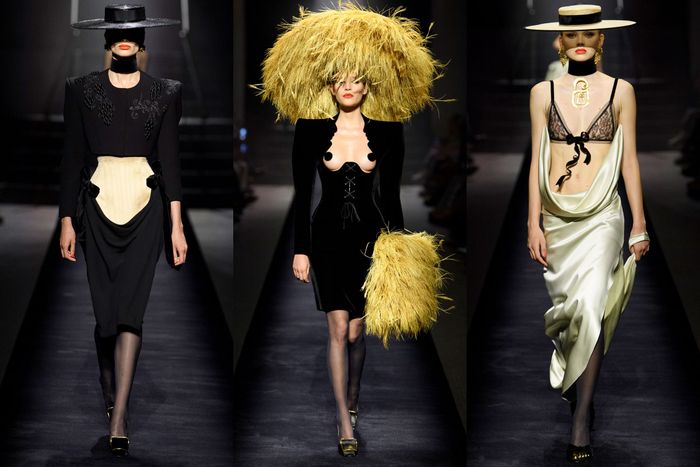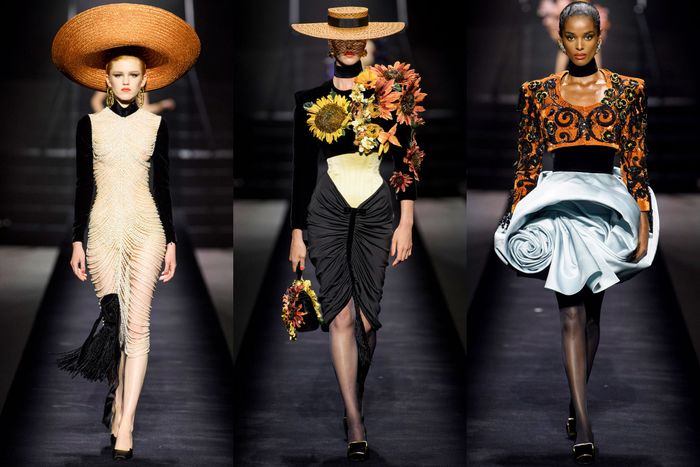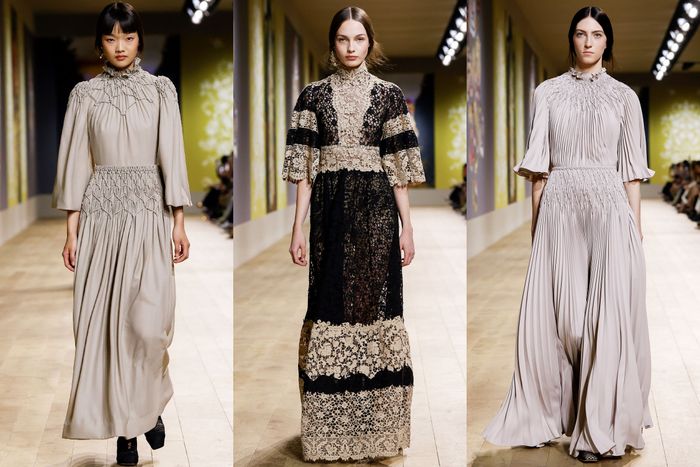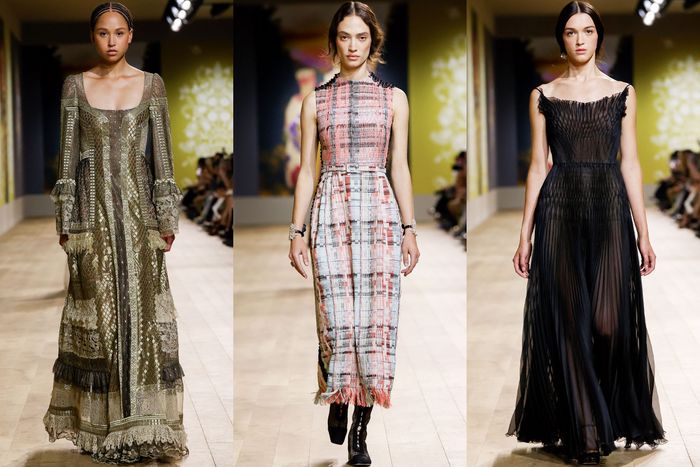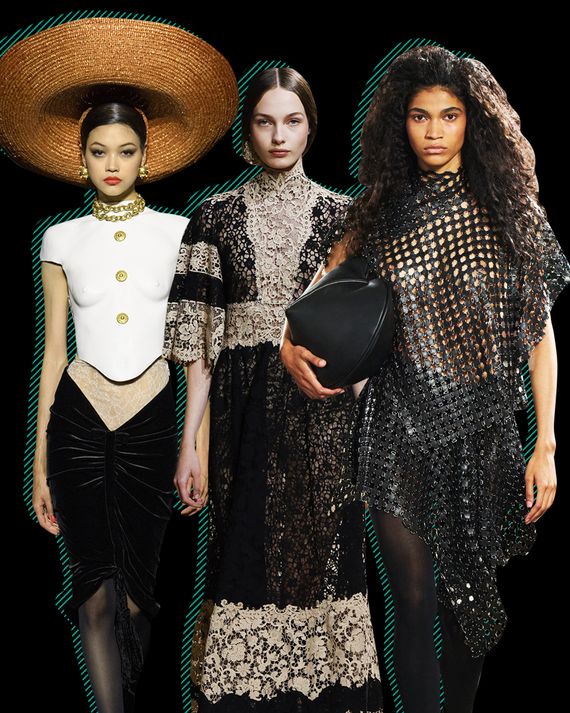
Photo-Illustration: byThe Cut; Photos: Courtesy of Schiiaparelli, Dior, Alaia
“Shocking,” the title of a new exhibition in Paris of the fashion of Elsa Schiaparelli, is indeed shocking. She did so much, from her Surrealist embroideries and hats to her witty perfume bottles (including one in the shape of a birthday candle), and she seemingly knew every major artist. You also see her influence on later generations of couturiers, most notably Yves Saint Laurent, Jean Paul Gaultier, and Christian Lacroix. When John Galliano did his newspaper-print dress in 2000 for Dior, he could thank Schiap. She did one in 1935.
The show, at the Musée des Arts Décoratifs, kicks off the fall haute couture collections — that is, the clothes that are made to measure for individual clients, not the global masses of luxury-goods shoppers. More than anything, though, “Shocking” reminds us that the 1930s was a time when women ruled fashion—Schiaparelli, Chanel, Vionnet, Grès. Each was a genius in her own right and at a crucial moment in the lives of women — when their bodies were freer and more mobile, thanks to the elimination of padding and corsets and the advent of sportswear and trousers — they made clothes that addressed modern realities.
We are again at a moment in history when the focus is on women, when the overturning of Roe v. Wade means unthinkable constraints on women’s lives, at least in the U.S. At the same time, there have been new and necessary demands placed on the fashion industry, above all to make clothes that are more environmentally sound and, as well, more representative of different races, genders, and body types. And like nearly all businesses and institutions over the past decade, fashion brands have been forced to adjust to social media — by making things that can be digested easily on a screen. As Pieter Mulier, the designer of Alaïa, said of the collection he presented the other night, “I wanted it very simple, that a silhouette could be read in a second and you would understand what it was.”
Schiaparelli, through no fault of her own, didn’t have to deal with a customer performing on TikTok. She just had to design beautiful clothes for women.
It’s no secret that social media has weakened aspects of the creative process in fashion, just as it has led to a shattering of norms and trust in institutions (the subject recently of a terrific essay by Jonathan Haidt). For one thing, it promotes the belief that consumers only react to things that are ostentatious or visually jarring. In short, that they are incapable of an emotional response to fashion — a striking silhouette, say, or an unusual combination of colors.
Alaïa.
Photo: Courtesy of Alaia
I would argue that “reading” a silhouette and feeling it are not one and the same, and that’s where Mulier’s came up short with this collection, his third as Azzedine Alaïa’s successor. (Though Alaia is not a couture house, Mulier has aligned his shows with the couture schedule, and I’m also including it here for reasons of relevancy.) Mulier started off with layers of stretch silk — bodysuits, dresses — that essentially covered the body but revealed its shape; these were just fine. But then he added asymmetrical skirts in a crisp white and ruffled fabric that looked unrelated to the clingy body outfits, and later he wrapped hips in front-knotted skirts with swags of material, including leather, that swept to the ankles.
Alaïa.
Photo: Courtesy of Alaia
I suppose you could say the silhouette was simple, and there were echoes of Alaïa’s shapes and references (to his native North Africa, for example), but the fit and the proportions seemed off. And one of the qualities of Alaïa’s designs that consistently got under your skin — and blew your mind a little — was that they looked completely resolved. You didn’t know how he achieved those amazingly feminine shapes of his; you just sensed the difference and wanted it.
That’s the missing ingredient at Alaïa now. I might add that many of its competitors are able to muster that emotional pull — Prada and Balenciaga, to name two — while still communicating clearly to a huge and distracted audience.
The fact is many people are fascinated by the craft tradition in fashion, not just by celebrities. Why else did Demna restart couture at Balenciaga (his second show will be on Wednesday)? In the three and a half months since Dior reopened its headquarters on Avenue Montaigne, 130,000 people have visited its galleries wing to see treasures from the archive, not only work by Christian Dior but that of his successors, including Galliano, Raf Simons, and the current women’s creative director, Maria Grazia Chiuri. And the Schiaparelli exhibition, which includes pieces by the new designer, Daniel Roseberry, will no doubt be a blockbuster.
Dior by Maria Grazia Chiuri.
Photo: Courtesy of Dior
But the fall couture shows of Chiuri and Roseberry, so wildly different in their approach to beauty, made me realize that the industry truly needs stronger female voices. It’s not that men can’t design great fashion for women; they obviously can and they do. But in the five years since Phoebe Philo left Celine, there has been a definite shift in the balance of views about women’s dress. What few people want to admit, because it suggests a binary trap, is that the dominant view of women is now male.
That may explain Roseberry’s theatrical gestures — the extravagant hats made of straw or ostrich feathers; the use of corsetry (either as discreet lacing on a plain dress or a section of a gown); the over-the-top embellishment (in the form of 3-D flowers); and the pouf skirts, swirled like a tight rosebud, that intentionally recalled early Lacroix. It may sound contradictory, but I didn’t mind in the least that Roseberry showed semi-naked bodies, with fabric seemingly sliced over part of a model’s torso and a breast trapped in a sling of dark red crystals. Many young women already show what they want in public, as I mentioned in a post last week about Marc Jacobs’s show.
Schiaparelli.
Photo: Courtesy of Schiaparelli
But the couture trappings, the expression of women as a luscious object to be unwrapped and devoured, are old-fashioned. His aim may be more camp or ironic, as he continues to play with Schiaparelli’s vast trove of Surrealist references, like her famous bureau-drawer suit with gold pulls — realized on model Carolyn Murphy, with weirdly beefed-up shoulders. But the approach is hardly new. (Giambattista Valli, who also showed on Monday, keeps women perennially in a male fantasy, his party skirts reaching parade-float proportions.)
Schiaparelli.
Photo: Courtesy of Schiaparelli
Chiuri avoided all of these gestures. “I think couture is a lot about that,” she said before her show, nodding at an easy, below-the-knee dress in pleated taupe crepe with smocking at the waist. “It’s something hidden and you have to know about it.” You’d have to know that the cording used for the smocking was actually a continuation of the pleats, not something added later for embellishment. Likewise, you would not be able to tell at a glance that a slim skirt and matching top in a sky blue, almost plaid pattern was woven on a small hand loom — the work of a young artisan named Aurelia Leblanc, who has made textiles for Dior for the past three seasons.
Dior.
Photo: Courtesy of Dior
Every style in the collection reflected the craft tradition, but thoughtfully brought forward in ways that looked fresh and realistic. The dominant dress was part hippie, part folk princess, in fabrics like lace, super-dry crepe, and sheer wool (for a gorgeous mustard-colored dress with an intarsia lace hem) that clearly and unceremoniously “read” couture. The earth tones, spiked with deep red or blue, and the double-face cashmere coats — some made of squares connected by tiny fiber hinges, allowing air between each — were all of apiece with the dresses and relaxed suits. That is, weightless.
“Nobody wants to have weight here,” Chiuri said, tapping her shoulders and frowning.
She also could have been talking about weightlessness in the largest sense — freedom of choice, freedom from assumptions about fashion. But she didn’t have to. It was clear in her designs.
Dior.
Photo: Courtesy of Dior
Chiuri isn’t an experimental designer by nature, except perhaps in her lively use of craft techniques, but she is a sensitive one, and her timing with the unhurried, seemingly uncomplicated look of this collection was impeccable. Coming out of a pandemic, with rising inflation and a war in Europe, the world seems intensely chaotic. And maybe clothes that feel like a pause, a breather, seem most right.
But everybody is also looking for an authoritative change, from a designer whose work speaks to many people. As a friend and former colleague said to me on Monday night, at a dinner to celebrate the opening of the Schiaparelli exhibition, “We’re all waiting for Phoebe Philo, for the return of motherfucking Theresa.” No word yet about when she will show her new line.

